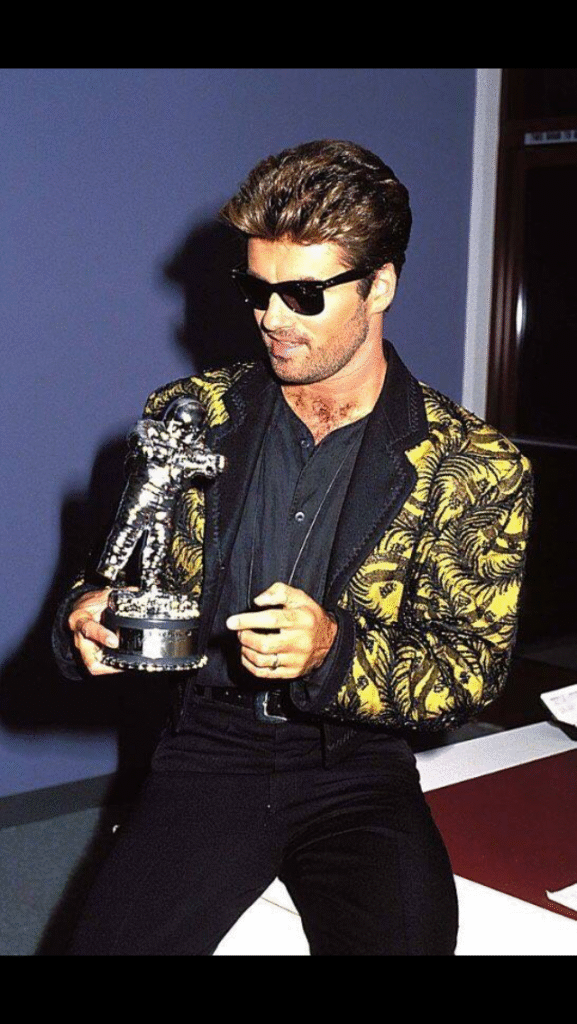
Never underestimate the power of a gifted singer-songwriter to inspire and inform your writing. George Michael—yes, that George Michael—wasn’t just a pop icon; he was a narrative architect. Every note, quiver, and carefully constructed lyric is a masterclass in building a story with emotional resonance. His songs didn’t just entertain—they lingered in our consciousness for decades.
This month, George Michael would have turned 62. If every novel were written with the same texture and truth as one of his songs, the pages would sing. Listening to George Michael doesn’t just inspire—it teaches. As a writer whose inspirations and preoccupations are rooted in the musicality of language, I return to George Michael’s music again and again—not just for his exquisite voice, but for the lessons on the craft of writing. When I’m stuck, when I’m unsure, when I want to remember why I write in the first place, I listen. And I learn.
This post isn’t just a tribute to George Michael—it’s a look at the powerful storytelling techniques behind his music and how writers can learn from them. George Michael wasn’t just a performer; he was a masterful songwriter and producer who crafted songs with emotional depth, structure, and intention. That same care and creative precision in songwriting offers a valuable example for writers, showing how layered, intentional work can create stories that stay with readers long after the final page.
1. Use voice, word choice, and Imagery to channel the story.
In Praying for Time, the meaning of the song is illustrated through George Michael’s vocal nuances and phrasing.
Take the opening lines:
“These are the days of the open hand / They will not be the last.”
The phrase “open hand” evokes a powerful image of generosity and vulnerability, while the word “last” emphasises the extension of the hand and the situation. A calm, steady delivery draws us in to reflect on ‘these days’ without decoration or distraction, while the long unrounded /ɑː/ vowel sound emphasises the lingering inequalities.
Later, he sings:
“Look around now / These are the days of the beggars and the choosers.”
The use of open vowels in this short, three-word command builds anticipation for the imagery to come. The beggars are on one side of the sentence, and the choosers on the other. The balanced sentence further emphasises the world of two halves: the “beggars” and the “choosers”.
Through expressive vocal techniques, the singer enhances the semantic content of the song. Just as Michael uses vocal nuances to deepen the listener’s understanding of lyrics, a writer uses sentence structure, word choice, tone, and rhythm to illuminate the deeper meaning of their words.
2. Make Your Rhythm Irresistible
Freedom 90 isn’t just about liberation—it feels like it. The rhythm matches the message. In prose, pace and syntax can do the same. Match the beat of your sentence to the beat of your emotion. Slow down. Speed up. But do it with intention.
Take the lines:
“But today, the way I play the game is not the same, no way
Think I’m gonna get myself happy”
The first line is delivered in two-word units, creating a heartbeat-like rhythm that mirrors the two syllables in the word freedom. This pattern builds a sense of excitement and heightens anticipation for what’s to come.
3. Surprise in the Final Act
Many of George Michael’s songs hold back their punch until the final act. That third-act twist? It’s not just for thrillers. Let your story evolve. Allow the unexpected—emotionally or structurally—when the reader thinks they know the tune.
In the song Carless Whisper, the rhythm is slow and smooth, like a slow dance, pulling the listener into a mood of quiet regret and resignation. There is a noticeable shift in rhythm and vocal delivery in the third verse. The vocal is more dynamic, with stronger, more pronounced phrasing, and the melody soars to a desperate plea for the lover to stay.
“Tonight the music seems so loud,
I wish that we could lose the crowd.
Maybe it’s better this way,
We’d hurt each other with the things we want to say.
We could have been so good together,
We could have made this last forever…
But now, who’s gonna dance with me?
Please stay.”
In the song, I’m Your Man, Michael uses a consistent laid-back funk baseline and a strong, lively drumbeat with some surprising beats. The instrumentation pulls back slightly in the final verse, and the vocals are more rhythmic and staccato, creating a conversational or teasing vibe to finish.
“I’ll be your boy, I’ll be your man
I’ll be the one who understands
I’ll be your first, I’ll be your last
I’ll be the only one you ask
I’ll be your friend, I’ll be your toy
I’ll be the one who brings you joy
I’ll be your hope, I’ll be your pearl
I’ll take you halfway ’round the world.”
If you’re a writer who loves music, listen to George Michael—not just for inspiration, but for songwriting techniques that create emotive and atmospheric stories. His music teaches how to structure, how to surprise, and how to feel. His songs encapsulate forms of memoir, confession, theatre, and prayer—often all in one breathy and rhythmic lyric.
Writing like George Michael means trusting your voice, letting emotion lead, and never being afraid to explore new creative pathways. It means becoming a channel for the art. So next time you sit down to write, put on Listen Without Prejudice and let the story take over.






